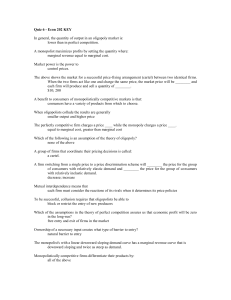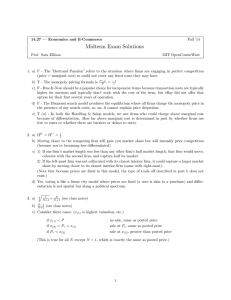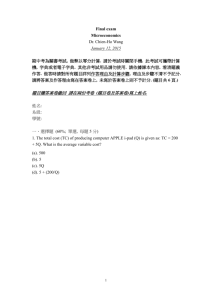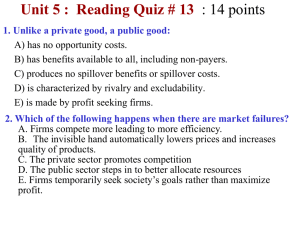14.01SC Principles of Microeconomics, Fall 2011
advertisement
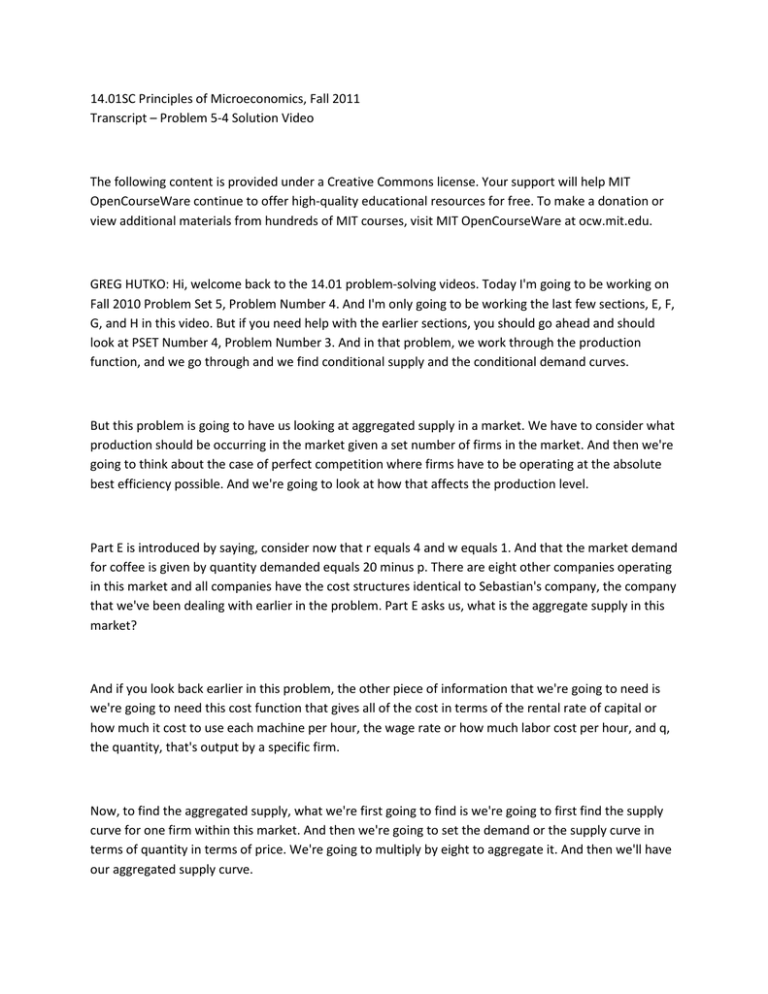
14.01SC Principles of Microeconomics, Fall 2011 Transcript – Problem 5-4 Solution Video The following content is provided under a Creative Commons license. Your support will help MIT OpenCourseWare continue to offer high-quality educational resources for free. To make a donation or view additional materials from hundreds of MIT courses, visit MIT OpenCourseWare at ocw.mit.edu. GREG HUTKO: Hi, welcome back to the 14.01 problem-solving videos. Today I'm going to be working on Fall 2010 Problem Set 5, Problem Number 4. And I'm only going to be working the last few sections, E, F, G, and H in this video. But if you need help with the earlier sections, you should go ahead and should look at PSET Number 4, Problem Number 3. And in that problem, we work through the production function, and we go through and we find conditional supply and the conditional demand curves. But this problem is going to have us looking at aggregated supply in a market. We have to consider what production should be occurring in the market given a set number of firms in the market. And then we're going to think about the case of perfect competition where firms have to be operating at the absolute best efficiency possible. And we're going to look at how that affects the production level. Part E is introduced by saying, consider now that r equals 4 and w equals 1. And that the market demand for coffee is given by quantity demanded equals 20 minus p. There are eight other companies operating in this market and all companies have the cost structures identical to Sebastian's company, the company that we've been dealing with earlier in the problem. Part E asks us, what is the aggregate supply in this market? And if you look back earlier in this problem, the other piece of information that we're going to need is we're going to need this cost function that gives all of the cost in terms of the rental rate of capital or how much it cost to use each machine per hour, the wage rate or how much labor cost per hour, and q, the quantity, that's output by a specific firm. Now, to find the aggregated supply, what we're first going to find is we're going to first find the supply curve for one firm within this market. And then we're going to set the demand or the supply curve in terms of quantity in terms of price. We're going to multiply by eight to aggregate it. And then we'll have our aggregated supply curve. But before we do that, we also have to think of a limiting case as well. When we're representing the costs for a firm, we're going to represent both the marginal cost and the average cost. The marginal cost is the cost of one single additional unit, while the average cost tells us all the costs including the fixed costs divided by the total that we're producing, what does that look like? If the price in a market is below the minimum of the average cost of a firm in the market, they're not going to produce in the market. So if the price is below this critical p star, since the firm, even if they're producing right at the minimum of average cost, they can never recover their cost. So a firm is only going to produce if this p where the price that's being charged is above the p star, the minimum of average cost. So we're going to find the supply curve in two cases, one where the price is above this minimum of average cost. And two, we're going to find it when the price is below that minimum. Let's start off by finding the marginal cost to get our supply curve. Taking the marginal cost, the derivative with respect to q. Or before we can take the marginal cost, sorry, let's plug-in for the variables w and r. We're going to find that our cost curve is given by 4 plus 4q squared. Now we can find the marginal cost, which will be our supply curve for a single firm. So in most cases, we know that this supply curve is going to represent the supply for a single firm where marginal cost, the price, is going to equal 8q. So in most cases, this will be our supply curve for one firm. Putting it in terms of q, we'll have q equals p/8. Now since we have eight firms, we multiply by 8. And in this case, we're going to have the aggregated quantity, which we represent by a capital Q. So that's the quantity produced by all eight firms in the market. And that's going to equal price. So this is one part of the supply curve. And what we need to know is, what's the critical price at which this will represent the supply curve? So when the average cost curve crosses the marginal cost curve, that's the minimum of the average cost. It's always like that for all cost curves for a producer. So if we set marginal cost equal to average cost, we find this critical p star at which the firm is going to produce at any price above that p star. So we're going to go back to our marginal cost. And what we have to do is we have to find the average cost as well to set it equal. To get the average cost, we're just going to go back up to our cost curve and we're going to divide through the whole thing by q. So the average cost is going to be 4 divided by q plus 4q. Now we're going to set average cost and marginal cost equal. And when we set marginal cost and average cost equal to find the intersection point on our graph, what we're going to find is we're going to find that critical p star is going to be equal to 8. So Qs is going to equal p for any price that's greater than or equal to 8. But what happens in the case where the price is less than 8? In that case, no single firm can make a profit by being in the market. So for any price less than 8, the production level is going to be equal to 0. Now we're going to move on to the next case. Now we're going to take the demand curve that we're given and we're going to calculate the equilibrium price, the aggregate quantity sold, and the quantity sold by each firm, and the economic profit of each firm. So let's start off in solving this problem, we're going to just assume that the price, the equilibrium price, is going to be greater than or equal to 8. And as we're solving through the problem, if we end up with a price that's less than 8, then we're just going to go back and we're going to say, OK, there's going to be no production, and we're done. But let's work with the assumption that we're working with this supply curve to begin with. All we have to do in this case is we're just going to set the supply curve we just found equal to the demand curve that's given in the problem. Solving through for p, we're going to find that the price in this market is going to be equal to 10. And plugging in the price back into the demand curve, you can find that the aggregate quantity is going to be equal to 10. So the price for each unit is 10 and the aggregate quantity is 10 as well. Now to find the quantity produced by each of the eight firms, all the firms, since they have identical cost structures, are going to be producing the same amount. So we're just going to divide this quantity by 8 to find the quantity produced by the individual firms. So each firm in this case produces 5/4 of a unit. The last thing that we have to do is we have to calculate the economic profits for each of the single firms. So the profit is going to be equal to the revenue, which is just price, times the quantity for a single firm. A big mistake here would be to use the aggregated quantity. And then you're going to subtract out the cost for each firm. And we're just going to use the cost function that was given after plugging in w and r. And this is going to represent the economic profit for each of the firms. And this leads right into the next part of the problem. It asks us, can this be a long run equilibrium where we have these prices, quantities, and profits? And why or why not? And how will the supply side of the market adjust in the long run? Now when other firms are considering entering the market, the only thing that they're going to consider is they're going to consider, is a firm that's existing in the market currently making profit? If they're not currently making profit, then the firm that's considering entering would have to have a better technology, a better way of producing at lower cost, to enter the market and be able to actually produce with a profit. But if there is profit being made, in this case 2.25 for each firm, then more and more firms are going to enter until profits are driven down to 0. So is this a long run equilibrium? The answer is no. And why not? More firms are going to enter on the supply side until we're driven to equilibrium. The last part that we're going to do is we're going to do part H. Part H asks us, what is going to be the price in the long run? How many firms will be present in this market in the long run? And how much will each firm produce? Now in the long run, we know that profits are going to be driven down to 0, and that each firm is going to have to be leaner and meaner. They're going to have to produce at maximum efficiency to be competitive within the market. So if we go back to the graph that we started with, we can look at, at which point are firms operating optimally? It's when marginal cost is equal to average cost. It's at this critical p star that we calculated to be equal to 8 earlier. So in the long run, all the firms are going to have to be lean and mean. They're going to have to operate at a very low average cost. And we're going to calculate how many firms are going to be in the market producing at this point where marginal cost intersects average cost. So to start off H, we know that p is going to be equal to the minimum of average cost, which we calculated in one of the earlier parts of the problem to be equal to 8. When we have this equal to 8, we can plug-in to our demand curve that price. And we can find that the quantity demanded is going to be equal to 12. Now what we can do now is we can go back and we can look at the individual supply curve for each firm. And each firm, when we had our individual supply curves that we calculated in the first part of the problem, had a supply function that was equal to q equals p divided by 8. And in this case, if we know that the price when the firms are operating optimally is equal to 8, then we know that each firm is going to be producing one unit of the good. So to find the total number of firms, we just have to take this aggregated amount, the total amount that's being produced, and divide through by the amount each firm is producing to find out the number of firms that have to be producing. So in the long run, we're going to have 12 firms each producing one unit at a price of 8, which is the optimal price where marginal cost is equal to the minimum of the average cost. So just to summarize what this problem had us look at, we looked at the case where we had instead of just one firm, we had multiple firms operating in a market. We saw that when we have multiple firms operating that if there's any economic profit that more firms are going to enter until the firms that exist in the market are forced to operate optimally with no economic profit. I hope that you found this problem helpful. And go ahead and again, you can do the earlier parts, and you can look to PSET 4 Problem Number 3 for help on those problems. MIT OpenCourseWare http://ocw.mit.edu 14.01SC Principles of Microeconomics Fall 2011 For information about citing these materials or our Terms of Use, visit: http://ocw.mit.edu/terms.

